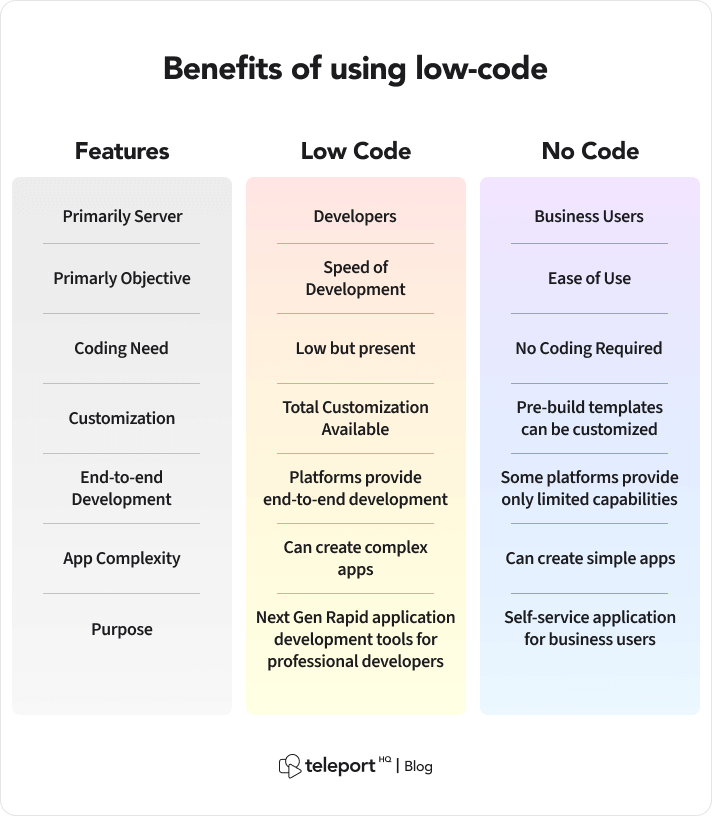Free Tips For Deciding On Low-code platforms for application development
Free Tips For Deciding On Low-code platforms for application development
Blog Article
The Advantages Of Low-Code Development For Speed
Visual Development Environment:
Drag-and-Drop Interfaces: Low-code platforms provide visual tools for designing applications. Drag-and-drop tools enable developers to rapidly build applications without writing extensive code.
Templates and components that have been pre-built Numerous platforms that can offer low-code support include templates and components that are pre-built, allowing developers to prototype quickly and develop applications without starting entirely from beginning from scratch.
Reduced Coding Required:
Automated Generated Code: Lowcode platforms generate the code base on the visual models that developers have created. This eliminates the requirement to write the code manually and speed up the process of development.
Reusable Components : Developers are able to reuse components in different projects to reduce the time spent writing and testing codes.
Collaboration is streamlined:
Low-code platform tools typically include testing, versions control deployment. This enables seamless collaboration between teams.
Citizen Development - Business users, non-developers and other users can all participate in application development through user interfaces that are intuitive. This helps to reduce the bottleneck created by the lack of availability of professional developers.
Rapid prototyping and rapid iteration
Rapid prototyping. Developers can design prototypes quickly to validate their ideas as well as get feedback. This will lead to a faster iteration cycle.
Easy Modifications - The visual nature low-code application development allows for simpler updates and modifications, which speeds up the refining of applications based on feedback from users.
Pre-built Integrations:
API Integrations. A number of low-code platforms offer connectors designed for the most well-known APIs and services. This could make it easier to integrate systems.
Data Integration: The instruments built within the software ease and accelerate the process of linking databases, applications and data sources.
Deployment & Scaling
One-Click Deployment: Many low-code platforms offer the option of deploying with one click, drastically cutting down on the time and effort needed to deploy software.
Cloud-based solution: Cloud based low code platforms are able to handle infrastructure management and scaling. This lets developers focus more on functionalities, application logic and features, rather than deployment logistics.
The most significant benefit of low code application development in terms of speed, is its capacity to automate and simplify a variety of aspects in the development process. This allows rapid delivery of software and faster adaptations to evolving demands. Take a look at the top helpful hints for blog advice including sso azure, application modernization, mobile development platforms, lowcode no code, application development platforms, app development platform, cloud software applications, developing mobile apps, app dev platform, push notifications and more.
The Low-Cost Of Development Is One Of The Main Advantages.
Low-code development offers many advantages in terms of cost-effectiveness. This is a great option for businesses that want to reduce their development budgets while providing high-quality applications. Here are a few of the most important advantages:
The low-code platform makes it less necessary to write lengthy manual coding. This saves time and effort on the part of developers when developing applications. This results in lower costs of labor.
Fewer Developers: Because low-code development is quicker and easier, there are fewer specialized resources for developers required. The cost of hiring and staffing could be significantly reduced.
Quicker time to market:
Accelerated Cycle of Development: Visual tools that are low-code and components enable rapid development of applications. This allows companies to launch their products more quickly. This may result in quicker revenue generation, and improved position in the marketplace.
Rapid prototyping: By constructing and testing prototypes quickly companies can decrease the amount of time they invest in the process of development and enable faster iterations on the basis of user feedback.
Lower cost of maintenance:
Because of their modular architecture and standardised components, low-code platforms typically allow for easier maintenance of applications. This can reduce the expense of ongoing maintenance and support.
Automated Updates: A lot of low-code software platforms manage patches and updates automatically, ensuring applications remain secure and up-to date without needing lengthy manual intervention.
Efficient Resource Utilization:
Contributions from Non-Developers: Low-code platforms enable people who are not developers to take part in the process of development. This allows companies to use the skills of many employees and reduce their dependency on highly-paid programmers.
IT Departments can Focus on Strategic Initiatives instead, of being overwhelmed by the daily development tasks IT departments are able concentrate their energies on strategic initiatives that improve productivity and efficiency.
Price models that are scaleable:
Subscription-based Prices: Many lowcode platforms are flexible and have subscription-based pricing plans that rise as users use them. This lets companies adjust their budgets according to their growth and requirements without the need to incur large initial expenses.
Pay-as-you-go Options Certain platforms offer pay-as-you-go options that ensure that businesses only pay for the resources they utilize and can be especially useful for small and new companies with a limited budget.
Reduced Third-Party Software costs:
Low-code platforms usually come with integrated functionalities that eliminate the need to purchase extra software or tools. This can help you save money on subscriptions and licensing costs.
Pre-Built Integrations: Availability of pre-built integrations for popular platforms and services eliminates the requirement for custom development, thereby saving time and money.
Improved ROI:
A faster return on investment: The combination of speedy development and lower costs, coupled with an increased time to market can help businesses get more return on their investment.
Improved Agility - Companies are able to swiftly adapt to changes in the market and changing customer needs. This lets them stay relevant and capitalize on opportunities that arise.
Training costs are cheaper:
User-Friendly Interfaces: The user-friendly interfaces and user-friendly functions of low-code platforms minimize the learning curve thereby reducing the need to conduct extensive training.
Accessible Resources: Many platforms that make use of low-code have an extensive range of training materials, tutorials and community support. This eliminates the requirement for formal education as well as the expenses associated with it.
Streamlined Collaboration:
Improved Collaboration Tool The built-in collaboration tool facilitates better communication and cooperation among team members. This leads to faster development processes and reduces project overhead.
Unified Development Environment. An unified development platform reduces expenses and improve workflows by simplifying the management of various tools.
In the end, the value of low-code application development stems in its ability to lower the cost of development and maintenance, accelerate time to market, maximize utilization of resources, as well as provide flexible pricing models. These factors combine to deliver significant financial benefits for businesses, making low-code a compelling option for companies looking to maximize their development budgets while also delivering high-quality, flexible and top-quality applications. View the recommended Legacy application modernization with Low-code hints for blog recommendations including developing mobile apps, developing mobile apps, rapid applications, push notifications, developing mobile apps, rad application development, lowcode no code, cross platform mobile app development, mobile app development platforms, software for app development and more.
Benefits Low-Code App Development In Terms Limitations And Customization
Low-code application design is a flexible, balanced approach that overcomes the limitations of the system and allows for customization. These are the main benefits: Handling limitations:
The Challenge of Overcoming Complexity
Low-code platforms simplify development by providing templates that are pre-built and other components. This allows rapid deployment and the development of more complex applications.
Many platforms have automated workflows that help developers navigate their way through the complex procedures. They decrease the chances of making mistakes and help maintain uniformity.
Scalability Solutions
Scalability is a part of the Low-code platforms typically include capabilities that permit the development of scalable architecture. Applications are able to handle higher workloads with minimal development.
Performance Monitoring Performance Monitoring Tools: Integrated performance monitoring tools and optimization tools ensure that applications are as efficient as they can be, no matter the size of their application.
Security and compliance:
Integrated Security Features: Low-code systems have security features built-in such as encryption, access control based on role, and automated compliance checks that address common security concerns.
Regular Updates: Platforms often update their security protocol and compliance procedures. This ensures applications remain protected against emerging threats.
Customization:
Extensibility:
Low-code platforms are often able to incorporate custom code, for instance, JavaScript or Python which allows developers to enhance their capabilities beyond the typical.
Custom Modules and Plugins: Developers can have the option of designing custom modules or plugins to customize specific functionality to meet specific business requirements.
APIs and Integration:
API Support: The extensive support for APIs facilitates seamless integration with external systems and services. This allows for customizing and connectivity.
Low-Code Platforms: These platforms offer pre-built connectors to well-known third-party service providers. This makes it easy to connect and modify apps.
Flexible Design for UI/UX
Customizable user interfaces: Developers can alter and design user interfaces to fulfill specific branding requirements as well as usability needs, providing an experience that is customized for users.
Responsive Designs: The software can be adapted to fit various screen sizes and devices.
Custom Business Logic for Businesses:
Visual Workflow Builders: Visual tools that allow you to build and modify workflows. business logic and processes allow developers to design complex and tailored processes without extensive programming.
Conditional Logic and scripting: Platforms permit the use of conditional logic, and scripting that is custom-made to handle specific business rules.
Data Management
Custom Data Models Developers have the ability to create customized data models that are tailored to specific business needs. This means that the handling of data is customized for every application.
Advanced Data Processing: The integration of advanced tools and capabilities to process data allow for customization of the way data is processed in an application.
How to balance customisation with limitations:
Frameworks & Standards
Low-code platforms encourage industry best practices and standards: Low-code platforms encourage adherence to industry-standard best practices and standards. This helps to maintain high-quality, secure and flexible applications.
Governance Frameworks. Built in governance frameworks help to ensure that modifications aren't detrimental to the integrity, security or security of the application.
Iterative Development and Feedback
Rapid Prototyping: Developers can quickly test and prototype customizations based on the feedback of users, improving the application in line with their preferences.
Low-code platforms have been designed to enable continuous improvement. This permits for modifications and improvements as requirements for business change.
User Empowerment
Low-code platforms allow citizen developers to develop: By allowing non-developers, by using intuitive interfaces to modify applications, they expand the number of contributors who can improve and customize apps.
Training and Support: Many platforms offer a wealth of training and support that can assist users in making effective customizations, without compromising application stability or performance.
Overall, low code application development provides a robust framework that can address the weaknesses and provides a wide range of options for customization. This allows businesses to develop and maintain applications that function, are tailored to their particular requirements and meet the highest standards in terms of security, quality, and scaling.